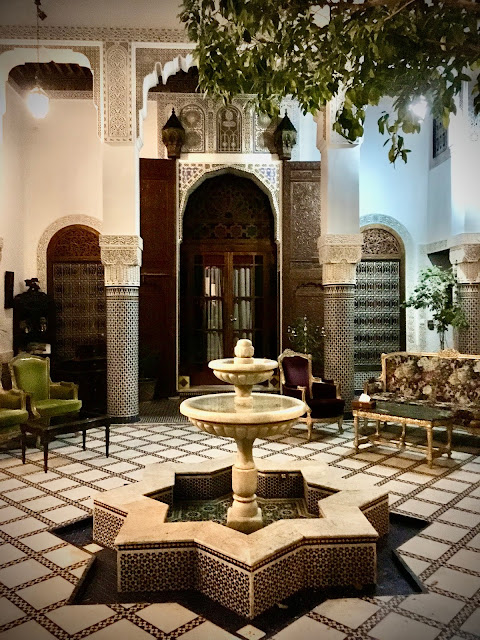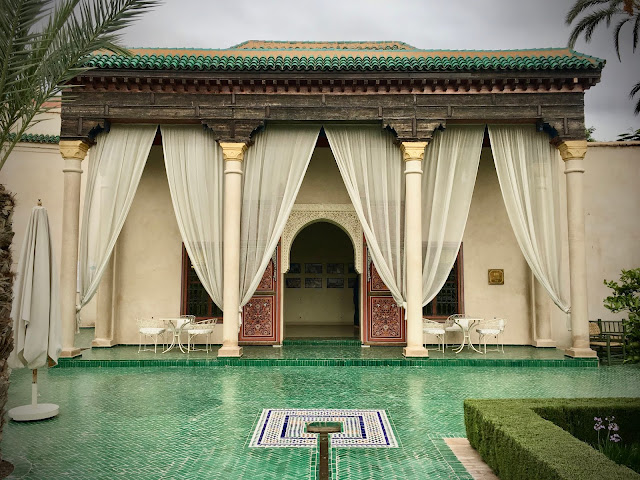In my previous post I wrote about the agriculture in Morocco as we had observed it on a trip there in November 2018. Morocco, however, is more famous for its beautiful architecture and gardens.
Riads
A
riad is a classical Moroccan house, usually 2 or more stories, with thick adobe walls surrounding a central courtyard. The front of the house is often just a door on a narrow street – though sometimes the door and entrance are highly decorated. Once inside the door a private Eden surrounds you. The courtyard is usually centered on a fountain or water feature surrounded by gardens. The thick exterior walls and the interior water features keep temperatures pleasant during the long hot summers of northern Africa. The more wealth you have, the more decorated your riad will be, with arches, carved plaster, tile work, fountains, and mosaic paving. Most of the places we stayed in Morocco were small hotels created by joining several riads together. Some larger properties created walled Kasbah resorts by buying up the surrounding properties to create a larger walled hotel with more expansive gardens. We stayed in several of these and visited others.
Villa Mandarine - Rabat
The first riad we stayed, Villa Mandarine in Rabat, was in the enclosed grounds tradition. It was originally of an orange grove owned by a French family. Over several generations they built a home and later turned it into a destination resort in 2001. Consequently, most of the structures are modern, but built and decorated in traditional rustic Moroccan style.
 |
| One of the many enclosed courtyards at Villa Mandarine |
 |
| Entrance to our room |
 |
| Enclosed Balconies of rooms overlooking the courtyard |
Riad Amine- Fez
In Fez we stayed our accommodations were constructed from several riads which were tied together and redecorated in traditional Moroccan style featuring lots of intricate tilework, pierced brass work, and carved plaster and woodwork. The entrance was down a very plain looking narrow street which didn't allow car traffic. However, once inside you entered a fabulous private eden. There were 2 main courtyards. One had a large reflection pool and the second had a lovely fountain. I could have stayed here several more days even though getting to our room was a climb via 4 long stairways to the top of the courtyard.
Palais Khum - Marrakech
Our last riad accomodation was in Marrakech and also was created from several older Riads and converted into a small boutique hotel. It too was down a very narrow alleyway. The decoration while based on traditional Moroccan designs were a bit more contemporary. Individual rooms were done in varying styles and ours was a mixture of Chinese and Moroccan.
 |
| One of the hallways connecting the courtyards at Palais Khum |
Kashbah Tamadot
The most impressive visit, by far, was Kasbah Tamadot, Sir Richard Branson's magical Moroccan retreat on the edge of the High Atlas Mountains outside Marrakesh. Branson discovered the Kasbah while hot air ballooning and bought it for his parents, fulfilling their dream of having a Moroccan getaway The Kasbah had been previously owned by Luciano Tempo, a renowned antiques dealer and interior designer, whose influence is visible throughout. Today it is a 28-room hotel perched on a hillside above a river-filled valley, with views up to 13,671-foot tall Mount Toubkal and down to the valley below. Picturesque Berber villages dot the surrounding hills.
 |
| The river valley and mountains where Kasbah Tamadot |
 |
| Rose petal floated on the surface of one of the courtyard pools |
You enter Kasbah Tamadot through a large, understated entrance and are quickly transported to a small city of Moroccan style buildings, pools, artwork and gardens. Scott's friends at Virgin Galactic had arranged a marvelous private champagne reception and luncheon for us on a patio perched over the river, with the snow capped High Atlas Mountains in the background. A refreshing breeze from the Atlantic wafted up the valley as we toasted our good fortune and dined in the bright sunshine. After lunch we were given a private tour through the dizzying array of arched walkways, vaulted passages, stairs and courtyards of the grounds and guest accommodations. Each room is uniquely decorated and has at least one private terrace, balcony or garden. The craftsmanship of the painted ceilings, tilework, spa bathrooms, rugs and textiles were utterly amazing. Numerous larger courtyards have fountains, swimming pools or seating areas to relax.
 |
| Crenelated roofs above one of the many courtyards |
The main buildings have crenelated roofs giving a castle or fortress-like appearance. Beyond the buildings are several more acres with a large pool area and gardens linked to glamorous Berber tent rooms.
Tent is a bit deceiving since the living areas are quite large and have permanent doorways, windows, skylights and enormous bathrooms complete with soaking tub. Outside are private patios in a garden setting.
 |
| A glamour Berber tent accommodation |
Video of artistry of Kasbah Tamadot:
This restored Riad in the middle of a crowded street in the Marrakech Medina. It had both a classical garden and a exotic garden. From their website:
 |
| Traditional Fountain bowl filling the rill |
 |
| A second rill |
La Mamounia - Marrakech
La Mamounia is one of the most impressive luxury resorts in Morocco, if not the world. It has the feeling of a royal palace with wonderful grounds, exotic gardens, impressive salons, courtyards, and architecture. We didn't stay or even eat there we we did stop by for a look around.
Plants of the Kasbah
There was a large vegetable garden area where much of the Kasbah Tamadot's fresh produce is grown. In a separate kitchen building a woman using a woodfired oven cooked the traditional Moroccan daily bread while sitting on the dirt floor.
The surrounding hillsides reminded me a bit of Santa Fe, New Mexico, with red dirt hills dotted with small pines and junipers and the unique blue-grey Moroccan cousin of the Mediterranean Fan Palm, Chamaerops humilis 'Cerifera'. The Kasbah grounds, however, were planted with more traditional Mediterranean plants that most of us would be familiar with--colorful bougainvillea, olive trees, Italian cypress, pomegranates, citrus and stone fruit trees, and a large variety of palms – including one very tall metal palm by the road outside that was hiding the cell tower.
 |
| That pesky cell-tower palm |
 |
| Planting beds being prepared for winter vegetables |
La Mamounia also had large growing grounds on the property, including greenhouses which produced much of the produce for the restaurants on site.
 |
| Unusual Peppers |
 |
| Hothouse growing tomatoes |
 |
| Eggplant |
 |
| Bed for salad greens |
Kasbah Tamadot encompasses much of the Moroccan traditional style, landscape, gardens and more, all in one destination. It was the last stop on our trip and one of the best experiences of a very memorable trip.
 |
| The high Atlas Mountains overlooking the rooftops of Kasbah Tamadot |
































Comments
Post a Comment